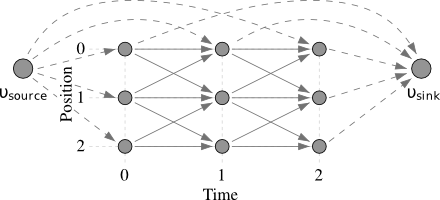This code implements a multiple object tracker based on the k-shortest paths algorithm. Its input consists in a set of probabilistic occupancy maps, that is, for every time frame, a set of occupancy probabilities, one for each of the potential target locations. Such input data is usually produced by an object detector.
The KSP object tracking algorithm is able to track an unknown and varying number of objects. Unlike other related methods, it operates on the full set of potential target locations, and not just on the detections themselves. This characteristic allows it to handle missing detections and false positives well.

Installation and test
The program should compile on any modern GNU/Linux system. Its only external library requirement is the Boost library, which needs to be installed along with its headers. To compile the program, simply use the make command.
To run a simple test on occupancy maps provided in the archive just type
./ksp test.ksp
It will generate a result file ksp-out.dat in the current directory. An alternate output file name can be specified with the option -o.
Configuration file
The program relies on a configuration file that contains all the parameters needed for applying the tracker. Below is a description of the syntax of this file. Note that the lines starting with a character # are considered as comments and ignored.
| GRID <grid_width> <grid_height> | The program assumes that the potential target locations are distributed as a regular grid. This command specifies the dimensions of this grid. |
| FRAMES <first_frame> <last_frame> | This command specifies the time window of the sequence to process. |
| ACCESS_POINTS <pos1,pos2,pos3,…> | This command specifies which – if any – cells of the grid can act as entrance and exit point, so that the number of objects can vary. In an indoor people tracking application, those would typically be locations close to doors, from which people can enter or exit. The set is given as a comma separated list of cells. A cell position is numbered by its coordinates in the grid: position = x + y * grid_width where the coordinates are defined in [0, grid_width[ x [0, grid_height[ . If there are no access point in the scene, this command should be commented out. |
| DEPTH <depth> | The depth represents the maximum allowed movement in the grid between two consecutive time frames. It is measured in grid cells. A value of 1 means that you can reach the next grid cell at most, while 2 means that you can travel 2 grid cells in any direction. |
| MAX_TRAJ <max_trajectories> | This value represents an upper bound on the number of trajectories retrieved by the algorithm. For implementation reasons, it cannot be larger than 255. |
| INPUT_FORMAT <input_file_format> | This string specifies the file format of the input data. Each time frame is stored in a different file, and every file contains, at each line, the number of the grid cell and its probability of occupancy. Thus the input file format should contain a special character %d that will be replaced by the frame number, in the standard printf way. |
An example configuration file named test.ksp is provided for convenience. It performs tracking on the probabilistic occupancy maps stored in the folder proba. Note that this data has been generated with the POM people detector.
Data sets
Some of the multi-camera video sequences, that we acquired to test our people detection and tracking algorithms are available for download.
Code
The code is available in the following repository:
https://github.com/cvlab-epfl/pyKSP
References
For more information about the KSP algorithm, please check the following article:
Please note that the publication lists from Infoscience integrated into the EPFL website, lab or people pages are frozen following the launch of the new version of platform. The owners of these pages are invited to recreate their publication list from Infoscience. For any assistance, please consult the Infoscience help or contact support.
Multiple Object Tracking using K-Shortest Paths Optimization
IEEE Transactions on Pattern Analysis and Machine Intelligence. 2011. Vol. 33, p. 1806–1819. DOI : 10.1109/TPAMI.2011.21.License
The source code is available upon request for academic purposes only and is distributed under a proprietary non-commercial license. If you are interested in using this algorithm in a commercial product, you can contact us to purchase a commercial license.